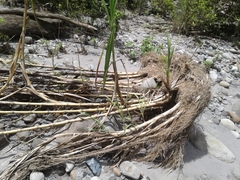
Neotropical Flora
|
Family: Poaceae
|
Uva grass, Wild cane, Cana blanca Large, dioecious perennial, usually to 3.5 m tall (frequently taller elsewhere); culms glabrous, becoming woody, to 1.5 cm or more diam, frequently branching near the base and sometimes with stout, leafy stolons. Sheaths longer than the internodes, with a long patch of pilose-woolly trichomes on the outside below the blades and also along the margins near the apex; blades to 1 or 2 m long, 4-6 cm wide, forming a fan-shaped summit on a sterile culm. Panicles 1 m or more long, the branches erect to drooping, white turning reddish-brown; pistillate spikelets with glumes very unequal, the first 4-5 mm long, the second 9-12 mm long and scabridulous, the lemma narrow, tapered to a long awn, together with the awn 6-10 mm long, with long spreading-pilose trichomes exceeding the awn; staminate spikelets with glumes +/- equal, 2-3 mm long, the lemma glabrous. Fruits narrowly oblong, ca 1 mm long, brown. Croat 10384. Occurring on shore on the steep banks of the north shore and on the few sandy beaches, where large lateral runners may extend considerable distances across the beach front, producing numerous erect branches. Flowers throughout the year, especially in the early rainy season. Southern Mexico to Paraguay; West Indies. In Panama, known from tropical moist forest in the Canal Zone and vicinity and in Darien. See Fig. 45. |
Powered by Symbiota.


















